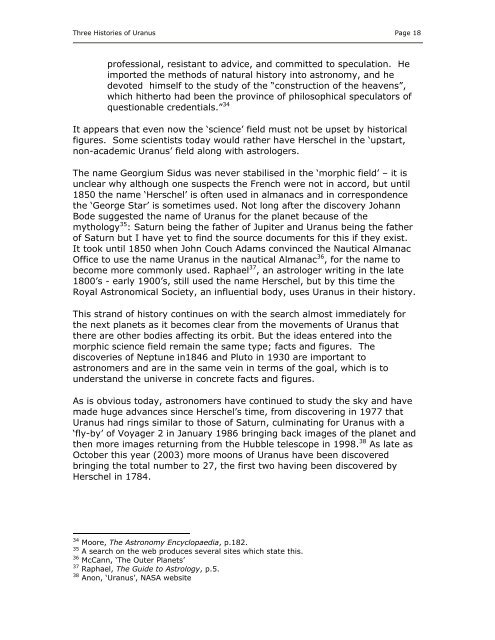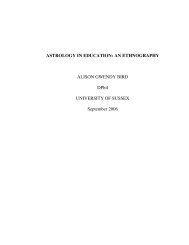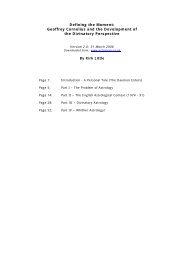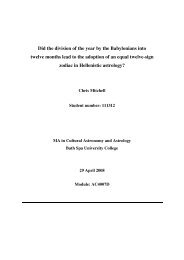Three Histories of Uranus - Astrology in the Year Zero
Three Histories of Uranus - Astrology in the Year Zero
Three Histories of Uranus - Astrology in the Year Zero
You also want an ePaper? Increase the reach of your titles
YUMPU automatically turns print PDFs into web optimized ePapers that Google loves.
<strong>Three</strong> <strong>Histories</strong> <strong>of</strong> <strong>Uranus</strong> Page 18<br />
pr<strong>of</strong>essional, resistant to advice, and committed to speculation. He<br />
imported <strong>the</strong> methods <strong>of</strong> natural history <strong>in</strong>to astronomy, and he<br />
devoted himself to <strong>the</strong> study <strong>of</strong> <strong>the</strong> “construction <strong>of</strong> <strong>the</strong> heavens”,<br />
which hi<strong>the</strong>rto had been <strong>the</strong> prov<strong>in</strong>ce <strong>of</strong> philosophical speculators <strong>of</strong><br />
questionable credentials.” 34<br />
It appears that even now <strong>the</strong> ‘science’ field must not be upset by historical<br />
figures. Some scientists today would ra<strong>the</strong>r have Herschel <strong>in</strong> <strong>the</strong> ‘upstart,<br />
non-academic <strong>Uranus</strong>’ field along with astrologers.<br />
The name Georgium Sidus was never stabilised <strong>in</strong> <strong>the</strong> ‘morphic field’ – it is<br />
unclear why although one suspects <strong>the</strong> French were not <strong>in</strong> accord, but until<br />
1850 <strong>the</strong> name ‘Herschel’ is <strong>of</strong>ten used <strong>in</strong> almanacs and <strong>in</strong> correspondence<br />
<strong>the</strong> ‘George Star’ is sometimes used. Not long after <strong>the</strong> discovery Johann<br />
Bode suggested <strong>the</strong> name <strong>of</strong> <strong>Uranus</strong> for <strong>the</strong> planet because <strong>of</strong> <strong>the</strong><br />
mythology 35 : Saturn be<strong>in</strong>g <strong>the</strong> fa<strong>the</strong>r <strong>of</strong> Jupiter and <strong>Uranus</strong> be<strong>in</strong>g <strong>the</strong> fa<strong>the</strong>r<br />
<strong>of</strong> Saturn but I have yet to f<strong>in</strong>d <strong>the</strong> source documents for this if <strong>the</strong>y exist.<br />
It took until 1850 when John Couch Adams conv<strong>in</strong>ced <strong>the</strong> Nautical Almanac<br />
Office to use <strong>the</strong> name <strong>Uranus</strong> <strong>in</strong> <strong>the</strong> nautical Almanac 36 , for <strong>the</strong> name to<br />
become more commonly used. Raphael 37 , an astrologer writ<strong>in</strong>g <strong>in</strong> <strong>the</strong> late<br />
1800’s - early 1900’s, still used <strong>the</strong> name Herschel, but by this time <strong>the</strong><br />
Royal Astronomical Society, an <strong>in</strong>fluential body, uses <strong>Uranus</strong> <strong>in</strong> <strong>the</strong>ir history.<br />
This strand <strong>of</strong> history cont<strong>in</strong>ues on with <strong>the</strong> search almost immediately for<br />
<strong>the</strong> next planets as it becomes clear from <strong>the</strong> movements <strong>of</strong> <strong>Uranus</strong> that<br />
<strong>the</strong>re are o<strong>the</strong>r bodies affect<strong>in</strong>g its orbit. But <strong>the</strong> ideas entered <strong>in</strong>to <strong>the</strong><br />
morphic science field rema<strong>in</strong> <strong>the</strong> same type; facts and figures. The<br />
discoveries <strong>of</strong> Neptune <strong>in</strong>1846 and Pluto <strong>in</strong> 1930 are important to<br />
astronomers and are <strong>in</strong> <strong>the</strong> same ve<strong>in</strong> <strong>in</strong> terms <strong>of</strong> <strong>the</strong> goal, which is to<br />
understand <strong>the</strong> universe <strong>in</strong> concrete facts and figures.<br />
As is obvious today, astronomers have cont<strong>in</strong>ued to study <strong>the</strong> sky and have<br />
made huge advances s<strong>in</strong>ce Herschel’s time, from discover<strong>in</strong>g <strong>in</strong> 1977 that<br />
<strong>Uranus</strong> had r<strong>in</strong>gs similar to those <strong>of</strong> Saturn, culm<strong>in</strong>at<strong>in</strong>g for <strong>Uranus</strong> with a<br />
‘fly-by’ <strong>of</strong> Voyager 2 <strong>in</strong> January 1986 br<strong>in</strong>g<strong>in</strong>g back images <strong>of</strong> <strong>the</strong> planet and<br />
<strong>the</strong>n more images return<strong>in</strong>g from <strong>the</strong> Hubble telescope <strong>in</strong> 1998. 38 As late as<br />
October this year (2003) more moons <strong>of</strong> <strong>Uranus</strong> have been discovered<br />
br<strong>in</strong>g<strong>in</strong>g <strong>the</strong> total number to 27, <strong>the</strong> first two hav<strong>in</strong>g been discovered by<br />
Herschel <strong>in</strong> 1784.<br />
34<br />
Moore, The Astronomy Encyclopaedia, p.182.<br />
35<br />
A search on <strong>the</strong> web produces several sites which state this.<br />
36<br />
McCann, ‘The Outer Planets’<br />
37<br />
Raphael, The Guide to <strong>Astrology</strong>, p.5.<br />
38<br />
Anon, ‘<strong>Uranus</strong>’, NASA website





